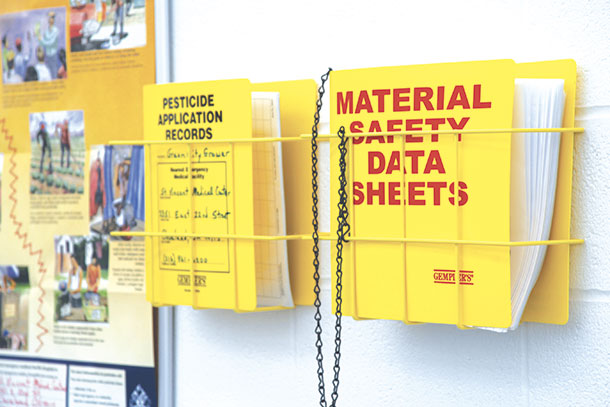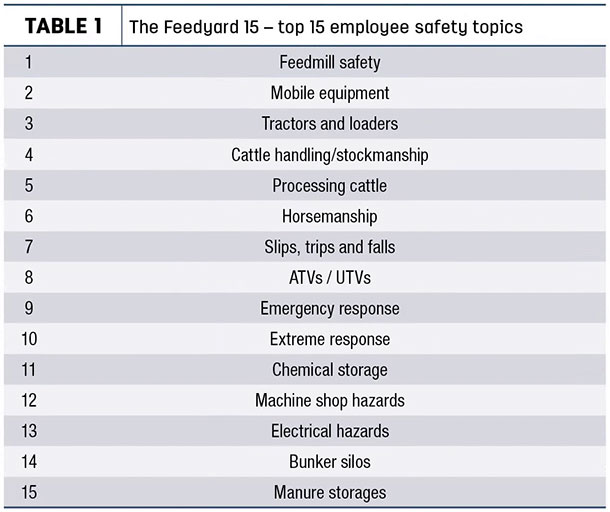This rate was four times higher than the rate in the agriculture, forestry and fishing sector overall (24.9 per 100,000) and 34 times higher than the rate in all industries combined (3.4 per 100,000).
The cattle feedlot subsector also has exceptionally high nonfatal injury and illness rates. Hired workers in the beef industry (including feedlots) have a “days away from work” rate of 358.8 days for every 10,000 days worked, while the rate for all industries combined was 99.9 per 10,000.
These high injury, illness and fatality rates may be partly due to high turnover among feedlot employees. Many come to work with little experience with cattle and no safety training related to these new jobs. The industry is competitive and owner-operators strive to improve their efficiency.
Labor represents a major part of production costs, and high workers’ compensation premiums add to the costs. There is increasing recognition that reducing injuries and illnesses among workers is a critical part of retaining a skilled workforce, decreasing losses and improving sustainability of the operation. We are seeing an increasing demand and opportunities for employee safety training.

A new project at the University of Nebraska Medical Center’s Central States Center for Ag Safety and Health (CS-CASH) is working to change these high injury rates and reduce the burden of injuries on cattle producers.
The first phase of this project is to inventory the currently available materials that can be used for feedlot employee safety training and survey the industry regarding their employee safety training needs. If you are interested in participating in this survey, you can find it online (NC - Cattle safety training survey).
Preliminary results from this survey show that cattle producers prefer hands-on training for their employees. Producers have also identified cattle handling and use of horses as the activities where employees are at greatest risk for injury. Slips, trips and falls were identified as the most frequent source of injury.
The Cattle Feedlot Safety Program through CS-CASH is working on compiling resources that can be used by cattle producers to conduct safety trainings with their employees based on the topics identified through surveys, insurance companies, and other safety and health experts.
The top 15 employee safety topics identified have been labeled the Feedyard 15 (Table 1).

These 15 topics will also be used to develop a feedyard safety program that will be implemented in the CS-CASH region. The resources created for this project will also be available online to anyone through the CS-CASH website.
There are many great sources for materials related to these topics out there, but they can be difficult to located and this is a time-consuming process. The goal of this program is to make employee safety training easier for employers.
Safety needs
Cattle producers have an increased risk of injury from a slip, trip or fall because of the variety of surfaces they encounter on a regular basis. Areas which have a greater risk for these types of injuries include: sloped terrain, feedlots, feed and cattle processing areas, ladders, and equipment steps or platforms.
Trips occur when an object catches your foot and causes you to fall in any direction. Tripping hazards include cords, equipment, uneven floors and unexpected objects. Potential tripping hazards should be removed from the worksite.
Slips occur when your foot slides, causing a loss of balance. Slipping hazards include wet, icy, greasy, or soiled ground or floors. Workers should wear appropriate footwear for the job, such as slip-resistant boots. Also, take the time to clean up any spills, especially oily and loose materials.
Falls occur when an individual descends or drops freely by the influence of gravity. A fall can happen from any surface, however, falls from higher elevations such as ladders, large equipment, elevated surfaces, ramps or platforms have a higher risk for injury.
Preventing these injuries
Proper housekeeping and lighting of working and walking surfaces can prevent many slips, trips and fall incidents. However, some additional guidelines to consider when working in an agricultural environment include:
- Maintain good housekeeping in livestock barns and work areas by removing manure and keeping surfaces clean and dry.
- Remove obstructions from travel areas, such as extension cords, power cords, hoses, boxes or tools.
- Repair uneven and/or warped flooring, protruding nails, splinters and loose boards, or cracks in concrete which can create an uneven walking surface.
- Sweep loose hay or grains from areas where those materials are handled and stored.
- Use handrails or grab bars in areas where there are stairs or changes in elevation.
- Use three points of contact when mounting or dismounting equipment and using ladders (one hand and two feet or two hands and one foot).
- In wet or slippery conditions, take smaller steps and try to ensure your body stays balanced over your feet.
- Use slip-resistant matting or provide textured surfaces in potentially slippery areas.
- Use the proper ladder for the job.
- Minimize distractions to remain alert to hazards, and avoid carrying bulky items that block your view.
Remember that reducing injuries and illnesses among workers is a critical part of retaining a skilled workforce, decreasing losses and improving sustainability of the operation. Whether you are just starting a safety program or you have much experience, many resources are available to assist you with improving your efforts.
Look for more resources coming from CS-CASH soon. If you would like assistance with your program, feel free to contact me. ![]()
PHOTO 1: A safety program is being developed at the University of Nebraska to help make it easier for the cattle-feeding sector to conduct safety trainings and ultimately, lower the rate of injury, illness and fatalities. Staff photo.
PHOTO 2: Recordkeeping and reporting are an important part of any safety program, like making pesticide application records and safety data sheets available to all employees and visitors. Photo provided by Aaron Yoder.

-
Aaron M. Yoder
- Central States Center for Ag Safety and Health
- University of Nebraska
- Email Aaron M. Yoder
Additional resources for preventing slips, trips and falls
Preventing injuries from slips, trips and falls from University of Florida Extension
More on slips, trips and falls from back safety/lifting/slips/trips/falls
Slips, Trips, and Falls from Ohio State University Extension
Slips, Trips & Falls from AgriSafe
Preventing slips, trips and falls on farms from WorkSafe New Zealand







